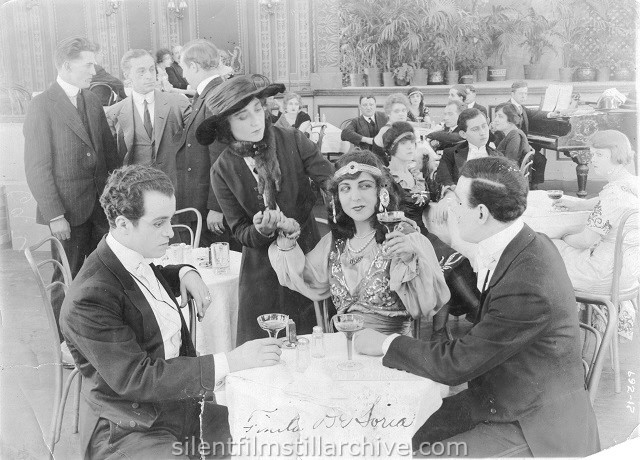![]()

Thrown to the Lions (1916)

692-17 George Daly, Mary Fuller, Finita De Sopia and unknown. [Photo courtesy of Chuck Slaker.]
"Thrown to the Lions"
Mary Fuller Featured in Five-Reel Red Feather Production Which Deals Authoritatively with Modern City Life
Reviewed by Robert C. McElravy.
IT IS always thumbs down for simple virtue, today as in the days of Nero. That is the analogy carefully worked out in this five reel subject. The short prologue and epilogue, in fact, date back to the time of the cruelest of emperors, picturing a Christian girl at the mercy of the beasts, while the Roman populace looks on.
But there were heroes then, as there are heroes now, to come to the rescue of outraged maidenhood, and the hopeful note is uppermost in this strong offering.
The scenario was adapted by Robert Lusk from a story by Wallace Irwin, whose vigorous fiction is well known to magazine readers. Mary fuller does some of her bet work in the part of Linnie Carter. She is personally appealing and plays with restraint and intelligence. She is assisted by a pleasing cast, which includes Joseph W. Girard, Finita De Sopia, Clifford Gary and Augustus Phillips. Joseph Girard also does some excellent work as the political boss.
The production, barring the opening and closing scenes, intensely modern in tone. It pictures the experiences of a girl who sith a friend, sets out to win her way by singing for a living in a café. She is made the victim of a fake marriage by the political boss, and saved by her comedian friend, Billy Weed. Then the district attorney falls in love with her, but breaks the engagement on the eve of their wedding. Again the comedian proves himself her true friend, and in the end she gives her love to him.
There are some highly dramatic episodes in the latter part of the production: the mock marriage, shooting of Sullivan by the gunmen, and the latter's false accusation on his death bed are all well handled. Not so much from the standpoint of novelty, for almost everything in this number has been done many times before, but because it is a consistent and well-rounded picture of metropolitan life of today, is this to be called a strong subject. The settings and photography are in keeping with the care shown in other details.
-- Moving Picture World, April 15, 1916, page 460.
Mary Fuller in "Thrown to the Lions." Cabaret life drama from the story by Wallace Irwin. Thirteenth Red Feather Production. Directed by Lucious Henderson. Released April 24. Granting the people don't like to be "preached at," it must be admitted that they do like "to be shown." This big and thrilling emotional drama shows the cabaret life along the "gay White Way" and the dangers that confront an ambitious girl in a great city. Metropolitan characters abound and the scenes - the cabaret - the stage - behind the scenes - are not only the essence of realism, but as such they will prove a revelation to those unfamiliar with Broadway, the most famous street in the world. This picture is truly tremendous. Its prologue alone will make it famous. Scenes in ancient Rome, with Christian maidens literally thrown to the lions to make sport for the degenerate Emperor Nero, are depicted with a fidelity that will bring gasps of admiration and thrills of suspense from your patrons. Produced by any other concern this would be considered big enough to be labeled "special feature." Take a little tip from thousands of successful Exhibitors and book this quick. (Ad.)
-- Motion Picture News, April 15, 1916, page 2202
"THROWN TO THE LIONS"
(Red Feather - Universal - Five Reels)
REVIEWED BY PETER MILNE
WE hasten to state that this is not an animal drama, save in respect to a few allegorical scenes that preface the body of the picture. Quite the opposite, "Thrown to the Lions" is a feature dealing with the struggles of a cabaret girl to live straight.
It derives its title from the fact that the author has drawn a parallel between the innocent maidens of Nero's time who were thrown to the lions for the mere sport of the emperor and the unsophisticated girls of the present who are thrust out on the sophisticated world with no knowledge of its pitfalls.
Norbert Lusk wrote the scenario from a story by Wallace Irwin while Lucious Henderson produced it. The body of it is not novel but the ending is, for the girl who believes at last that she has found a trusting man is suddenly disillusioned when he believes the words of a profligate as to her past. It is an unusual finale and will no doubt evoke favorable comment.
The picture as a whole is strikingly entertaining. The situations are handled in a capable way with the result that the full force of their dramatic contents is realized. Together with the scenes, the great majority of which are staged in a very good cabaret setting and in the adjoining dressing room, the plot presents a most entertaining surface.
Linnie Carter is a cabaret entertainer with her friend Irma. Harry Sullivan, the ward boss, is very attentive to Linnie and finally asks her to marry. She consents believing his motives to be sincere.
Sullivan takes her to a hotel where a mock marriage is gone through. By this time Irma and a clown, Billy Wood, discover Linnie's danger. By a ruse they draw Sullivan away from the hotel and then rescue Linnie and tell her the truth. Time goes on and District Attorney Bryce meets and falls in love with the cabaret entertainer.
The day for their wedding is set. Gangster, on the lookout for Sullivan, shoot and mortally wound him, with the result that he lies to Bryce about Linnie's relations with him. Bryce believes all and turns to Wood as the only real man she ever met.
Mary Fuller registers in her usual attractive style in the role of Linnie. Joseph W. Gerard gives a consistently fine rendition of Sullivan's role and Augustus Phillips is equally good as Bryce. Finita DeSopia make a lively figure of Irma and Clifford Gray has the role of Wood, in which he is rather wooden.
-- Motion Picture News, April 15, 1916, page 2210
with Mary Fuller, Joseph W. Girard, and Finita De Sopia. Directed by Lucious Henderson. Universal/Red Feather.
More Information on this film...

This work (Thrown to the Lions (1916),
by Universal),
identified by
Bruce Calvert, is free of known copyright
restrictions.
Books
(none)
Last Modified June 4, 2016



















